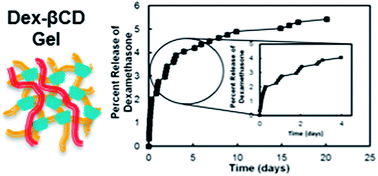Injectable, in situ gelling, cyclodextrin–dextran hydrogels for the partitioning-driven release of hydrophobic drugs†
Abstract
Injectable, degradable hydrogels based on cross-linking between aldehyde-functionalized dextran, hydrazide-functionalized dextran, and hydrazide-functionalized beta-cyclodextrin (βCD) were developed for hydrophobic drug delivery. βCD functions as both the in situ-gelling agent driving hydrogel formation as well as the binding site for the hydrophobic model drug, dexamethasone. In hydrogel systems where βCD is primarily covalently attached to the polymer network through cross-linking, the amount of drug release per sampling point is independent of the time between samples, the solubility of drug in the release medium, and the cross-link density of the hydrogel; instead, drug release is controlled primarily by partitioning of free (water-solubilized) drug between the hydrogel and the release medium. When the concentration of the hydrazide-functionalized dextran polymer was increased and more hydrazide groups were available to compete with βCD reactive sites for cross-linking the polymers, greater than ten-fold more drug was released from the hydrogel during the 20 day sampling period. Mobile, non-cross-linked βCD increases the solubility of the drug and facilitates rapid drug release by diffusion, as confirmed by quenching βCD-bound hydrazide groups. In this way, via a very subtle change in the composition of the injectable hydrogel, both the kinetics of drug release as well as the mechanism of drug release can be tuned over a wide range. Together with the low cytotoxicity of the materials, these results suggest that injectable βCD-based hydrogels have potential for facilitating controlled release of hydrophobic drugs over multiple time scales by controlling the mobility of βCD within the hydrogel network.


 Please wait while we load your content...
Please wait while we load your content...